If you were following me on Twitter on Monday morning, you’d know that I made a decision I came to regret: I travelled to work on the train to Caulfield and the express rail replacement bus into the City.
In short: the buses were hopelessly swamped by people. It was a long wait (43 minutes) in the bus queue; then a bus trip from Caulfield to the City that took more than an hour.
The trip that normally takes about half an hour from Bentleigh to the City instead took two hours.Read this Twitter thread for the grisly details.
In the cold light of day, here are some thoughts on this.
The good stuff.
The information has been pretty good. Lots of signage. Lots of staff making announcements on the train, on the station before the works started. It was pretty clear where to go.
There’s also been no shortage of advance warning: signs at local and CBD stations (the latter perhaps a little overwhelming), flyers handed out at stations, announcements on stations and trains, TV and radio advertising, press calls, web site updates.
There have been some errors along the way, and some of the media messaging was overly alarmist – leaving for instance some people assuming the Sandringham line is closed every day. It’s not – it’s only closed on some weekends. A simple calendar might have helped.
On the ground at Caulfield, they seem to have tweaked the verbal messaging from announcers to say “to the City”, which is much clearer (and more correct) than the previous “to Flinders“.
The massive tents at Caulfield are a smart idea. Ideally you don’t want long queues. But if you do have them, you especially don’t want people in long queues in the rain.
It reminded me a bit of the queues for rides at an amusement park. But not as fun.
I found passengers were remarkably calm while queuing. Maybe they were all posting furious messages on social media, but nobody got visibly shouty or upset, nobody jumped the queue, and (gods be praised) nobody lit up a cigarette inside the tent.
Metro was taking the operation seriously. I know this because I saw Metro CEO Raymond O’Flaherty walking around checking things out, with a suitably serious look on his face.
It’s school holidays and university mid-semester break (at least for some). This helps reduces travel demand, especially in the morning peak. The trains were quieter than usual. If these disruptions have to occur, now is the right time.
Running a stopping-all-stations every 7 minutes service from Frankston to Caulfield made sense to keep things simple and minimise passenger waits for trains. It’s similar on the Pakenham line, though Cranbourne passengers have to change at Dandenong, which adds to their travel time.
Happily for outbound passengers, trains on the Dandenong line run at least every 10 minutes until almost 10pm; until about 8pm on the Frankston line. High frequency makes outbound connections off the buses fairly easy.
On the bus there were delays due to traffic, but it seemed minimal delays due to just traffic lights themselves – apparently Vicroads was making some effort to cut delays to buses at lights, which was good… except…
Buses still faced long delays getting across Princes Highway because someone decided that cars on the highway are more important than scores of buses packed with people.
Edit: As far as I can make out, the express buses were split between Federation Square (via the M1) and Arts Centre (via Dandenong Road/St Kilda Road).
The problems
Train delays approaching Caulfield. Ours stopped for about six minutes, but this was nothing compared to some of the delays on the Dandenong line, with some trains stuck for an hour or more.
A big factor in this was crowding on the platforms. Caulfield station is not a modern design. Especially on platforms 2 & 3, the gates and ramps cause a bottleneck. (With the metro tunnel likely to increase Caulfield’s interchange role, an additional concourse would be a welcome upgrade.)
The track layout is also problematic – sometime in the past few years, the layout has been altered so that trains from Dandenong can only terminate on platform 3. The less busy Frankston trains could use platforms 1 & 2.
The sheer number of people meant crowding in the subway. The crowding in the subway backed up onto the ramp, and then up onto the platform, preventing empty trains from departing.
But the biggest problem was bus throughput. Standing in the queue for that 43 minute wait, there would be times when no buses at all would arrive for 5-10 minutes. Then a few would appear and fill up.
The crowds could have been handled much better if the stream of buses was constant.
“Buses replace trains”
— Daniel Bowen (@danielbowen) April 7, 2019
No, they really don’t. #TrainPain #bustitution #MetroTrains pic.twitter.com/k65FAL2PKt
Bus delays
Some express buses earlier in the morning had departed with spare capacity aboard, despite people still queuing. (This was actually shown in the timelapse in Channel 7’s news story.)
This needs fixing urgently – apart from making some in the queue needlessly wait, it wasted bus capacity that could have been used later in the morning to keep more people moving. Express buses shouldn’t leave unless full if people are waiting. Only stopper buses need to leave with space for more passengers.
Bus throughput was also affected by severe traffic delays – buses despatched to the City had a slow trip in, limiting the number of trips they could run.
- Unbelievably, Normanby Road in Caulfield was still available to general traffic in both directions, with buses having to negotiate a sea of bollards. Did they seriously not think to just close it off?
- There were also delays on Sir John Monash Drive for buses trying to enter and leave the precinct. Given the numbers of passengers, it would easily be justified to close down that section of the road (from Queens Avenue to Dandenong Road) to other traffic – or allocate an extra bus lane that can be used to get onto Burke Road.
- At the very least, more time should have been given for buses getting across Princes Highway.
- Each morning peak the M1 has been clogged. On my trip was a crawl from joining the freeway at Burke Road, up until about Toorak Road. (Can the automated signage on the “managed motorways” be programmed to show bus lanes? If not, maybe this should be factored into designs for future rollouts.)
- After leaving the freeway there was another crawl along Batman Avenue, mostly caused by the sheer number of buses.
At this point on my trip I was looking on Google Maps at the traffic further along and onto Flinders Street and thinking/hoping they’d route some buses over to the Arts Centre to avoid it – as has been the case during previous rail closures.
Unbelievably, they didn’t. Instead our bus and all the others headed straight into a kilometre-long queue of buses and other traffic.
You know how some people claim that unlike rail transport, buses can easily adapt to changing travel demand and traffic patterns. Yeah. Not unless someone tells the drivers.
Eventually bus drivers started letting passengers out to walk the rest of the way. As I walked, I found a long queue of buses all the way to Federation Square.
Authorities implied it was because of the vegan protestors occupying the intersection at Swanston and Flinders Street. I don’t buy that.
- Any westbound traffic delayed by the protest was separate from the bus route, because the section of Flinders Street used by the buses (from Exhibition to Russell Streets) was closed to other vehicles
- Exactly the same problem happened again on Tuesday morning – with no protestors. And again on Wednesday morning.
To me it looked like the bus jam was due to a slow turnaround at Federation Square. They should have been getting buses unloaded and out again as quickly as possible so they could get back to Caulfield and pick up more passengers. Again the despatch procedures seem to need reviewing.
The lack of a dedicated bus lane on Batman Avenue didn’t help either, though it wasn’t as big a problem as on the M1.
For a bus and it’s driver, the round trip would have been at least 60 minutes inbound plus 30 minutes outbound. No wonder there were queues at Caulfield.
Is the strategy right?
The government says 600 buses and coaches are being used this week for rail replacements, and presumably most of them are on the Caulfield to City run. But are they being used in the best way?
Getting everyone to Caulfield by train and then using lots of buses to the City worked during quiet times on the weekend when passenger numbers were lower. It struggled a bit with football crowds, but it really struggles with peak hour commuters.
It’s a firm reminder that buses can’t replace trains. It re-created the mess that occurs every weekday on the Doncaster corridor, where buses try to do that job.
The Doncaster buses are incredibly messy, but at least they have bus lanes on the freeway inbound, and along Hoddle Street and Victoria Parade. This was specifically ruled out by authorities – who chose instead to rely on traffic light priority (but then didn’t provide it crossing Princes Highway).
If they’re not going to give hundreds of packed buses the priority they deserve, would a better strategy be to shift more people onto the neighbouring rail lines, and run extra train services?
- A bus connection from Moorabbin to Brighton Beach on the Sandringham line (as used in the past) for people from stations further south
- Another from Westall to one of the Glen Waverley line stations for the Dandenong line passengers
With reduced holiday demand, and extra services, would they cope? (The Sandringham line is running extra services anyway – the usual 8 trains per hour in peak is 10 per hour during the works. These have been pretty crowded.)
There would be some level crossing impacts from more trains of course, but the shorter route for buses would mean fewer delays for them, and if enough extra trains could be provided, they would cope with passenger numbers so much better. (A packed train would be about 20 bus loads of people.)
For passengers closer in, the mix of stopping and express buses from Caulfield to the City would get a better run thanks to reduced passenger numbers and congestion – in the station at Caulfield and on the roads into Federation Square.
This sort of operation might use fewer resources, making the overall rail closure cheaper.
Boosting regular routes
A more radical change would be to run the above Westall and Moorabbin shuttle bus connections, but also deploy some of the hundreds of buses being used to boost local cross-suburban routes that connect the train lines, more widely distributing passengers across more stations.
Some passengers are seeking out these local tram and bus routes anyway, including some prompted by advice from Metro staff who knew about the chaos unfolding at Caulfield.
There have been reports of crowding on the 630 bus (North Road) and 67 tram (Glen Huntly Road) thanks to no extra services and (some) use of small trams. Presumably this is also an issue on the inner-suburban tram routes in the southeast.
For me, I used this method to get home on Monday. It was 58 minutes from Flinders Street to Bentleigh (via Middle Brighton and the 703), and that included a 17 minute wait for a late bus. Far better than the two hour trip in the morning.
Boosting those local bus routes and encouraging their use would be making the best use of buses – which are not really suited for long haul high capacity routes. It would also help educate passengers on their alternate routes during future unplanned shutdowns.
Obviously it’s a fine balancing act to try and make sure the swarms of passengers displaced by the rail shutdowns don’t swamp other services and replacement buses.
A good balance has not been reached this week.
The first weekday is always the worst. The queues at Caulfield have moved better on subsequent days. But that’s not an excuse.
It’s like when they say the first week of the university year is worst. Waiting for people to give up and try something else (such as driving) is not a good outcome. (Fair enough, for universities, sometimes travel patterns genuinely change after the first week or two.)
As of day three, the bus delays haven’t gone away – on the M1 and Batman Avenue, and around Caulfield, they have continued each peak hour.
The strategy used for this works period needs to be reviewed.
With continuing (and very welcome) works on level crossings, the metro tunnel, and upgrades for the new trains, these major rail closures will keep happening. While they do, the city and its transport network need to continue to function.
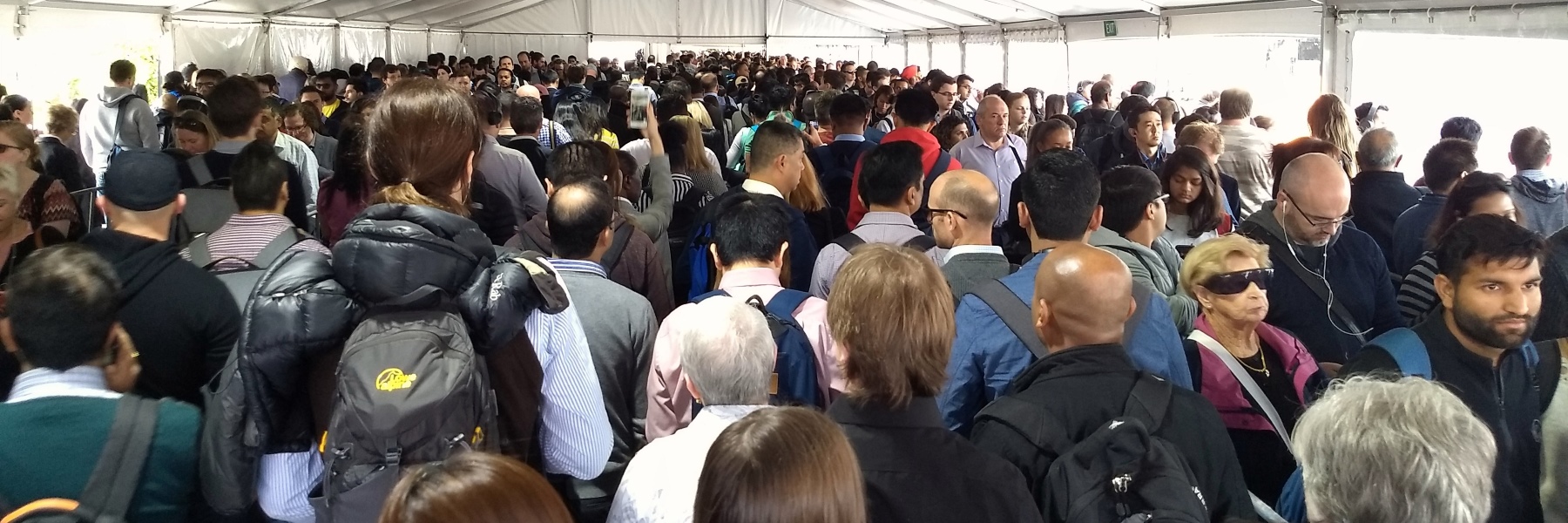
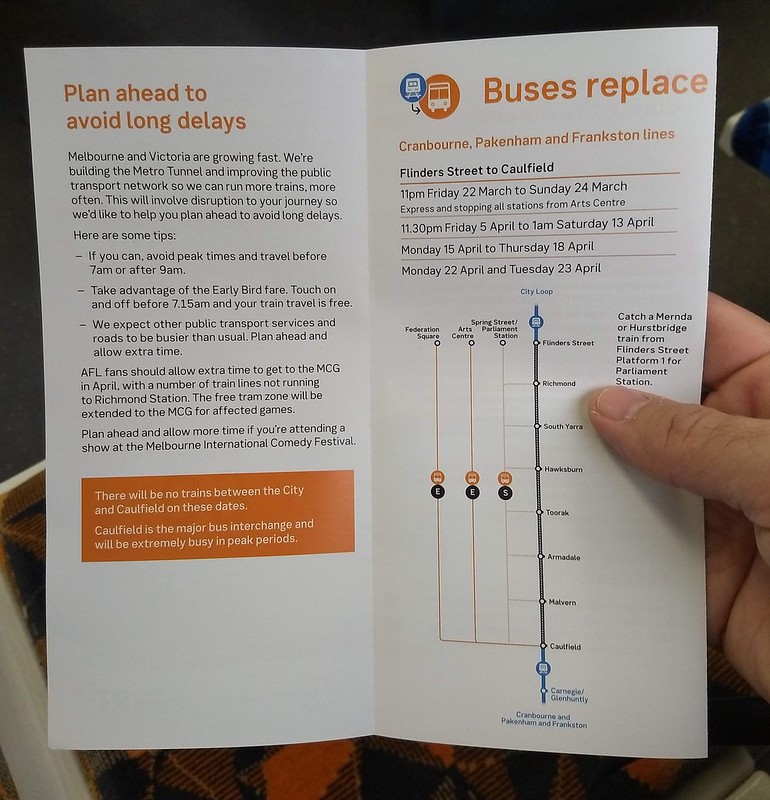
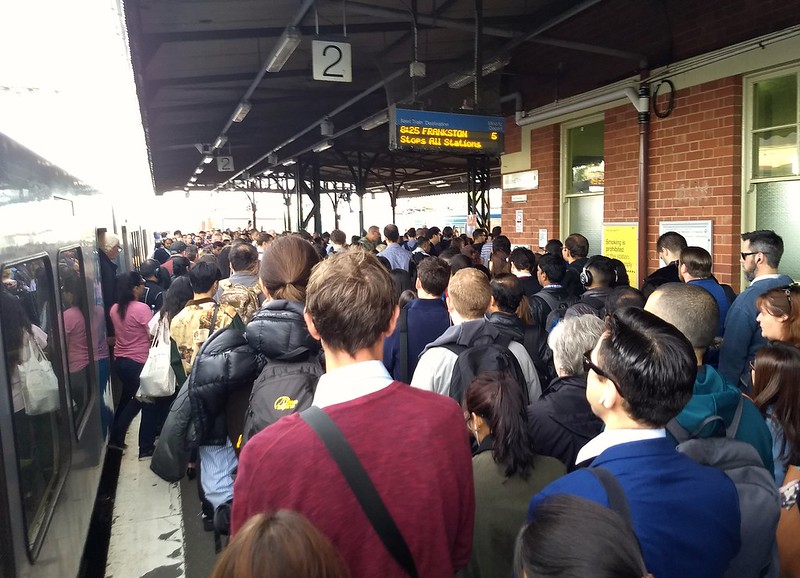

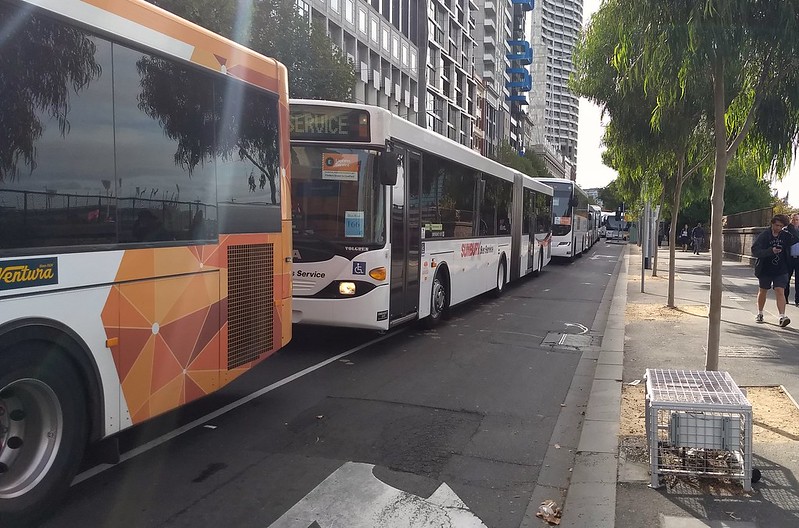
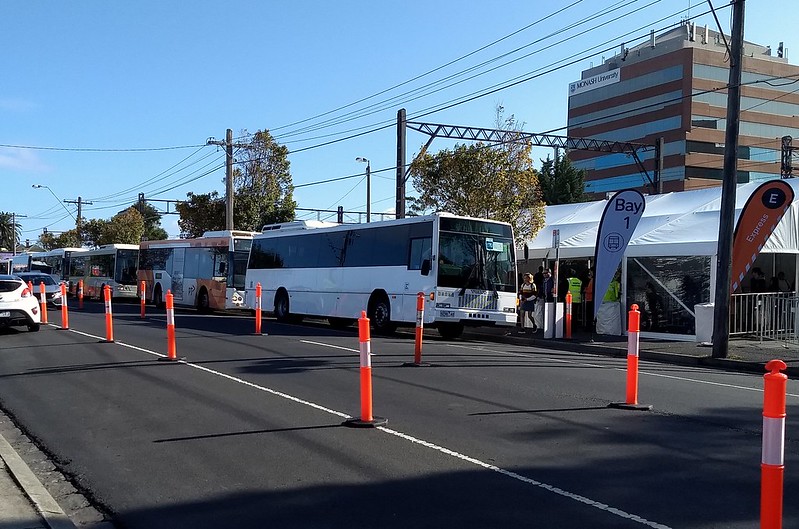

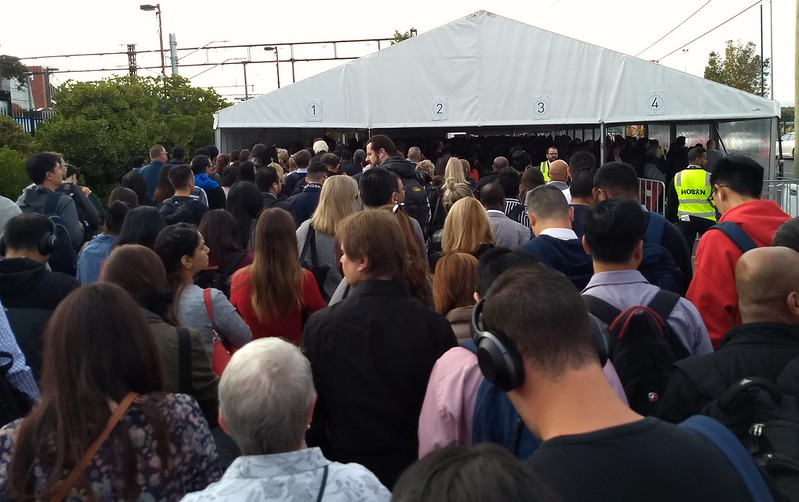
27 replies on “Train Pain”
If you could have that day over again, was there an alternate route that you could have taken in there morning that might have given you a faster or more pleasant journey?
An extended “bustitution” will definitely require dedicated albeit temporary bus lanes to cope with the amount of passengers that would normally occupy a number of trains.
It should be worth mentioning, I don’t know about the city unis, but Monash Caulfield’s mid semester break is after Easter when the buses finish. So I think they are limited in how they could shut those roads, also meaning that there is a lot of non-transferring passengers. Given the amount of people I know taking the days from Easter to Anzac off (I just got an email from my boss today encouraging it!) even though it’s not school holidays I wonder if it should have all been delayed a week.
On Monday, the impact would have been worse, with the Vegan blockade in the city.
Frankston line, you could have buses running Morabbin – Arts Center. These are more direct, have one main road straight in too.
What can you tell me, in respect to the impact on local tram services? Are trams running more frequently, or are higher capacity trams being used.
I would prefer using the #3 tram, especially if nobody else is.
Is it wise, for the buses to use the Monash?
I would have said, that Dandenong road would be much quicker, and perhaps not as busy as the Monash Freeway?
I know of many, who would normally take the train, are in fact driving. Including into the city. The Monash is at the best, very busy in peak, it can only be somewhat worse now with many more automobiles on the road.
@Alex, the 703 to North Brighton then Sandringham line would have been far, far quicker. But then I wouldn’t have such good photos for this blog!
@Jessica, thanks for that. There is more they could have done, such as banning (or discouraging) through traffic, or only permitting cars one way along Normanby Road and Sir John Monash Drive, to allow more space for buses.
@Jim, I know this is a long post, but virtually every question you’ve asked is covered. In particular I have explained why the Vegan protest would not have impacted the buses.
(I have added a clarification: express buses were split between the M1 to Fed Square and Dandenong Road to the Arts Centre)
The Sandringham line had a paltry two citybound services added temporarily in morning peak, so from Elsternwick between 730am and 9am, a train leaves about every 6.5 minutes rather than 7.5 minutes. Still better than the Glen Waverley line which had no services added at all. There are still two weeks to fix this.
Perhaps a change in off-peak frequency from 15 minutes to 10 minutes for both lines would help encourage fewer people to travel during peak too, especially if it’s properly promoted.
I’ve chosen to leave home earlier (I travel in from Frankston all the way to the city), and leaving work earlier and have been able to avoid queues at both ends of the day. Mind you the train from Frankston to Caulfield on it’s own is taking an hour, so that’s a bit frustrating. But it’s all for the greater good, and I have a supply of books to keep me occupied during the disruptions.
Has anyone looked at the option of using the trams instead? I know it might not be 100 percent as good though but I’ve been doing that instead. Despite the crowding to me it’s less of a headache than the busses. And at least St Kilda road has priority for the trams too :)
Re Caulfield, there have been staged changes over the last few years. One of the negative outcomes of the Skyrail+HCMT projects is the nerfing (bordering on castration) of Caulfield, Oakleigh and Dandenong.
December 2017 – Points 608U, 608D, 610D, 613U, 613D, 623, 633, 652 & 662 spiked + 610U & works platform removed
April 2018 – Points 613U, 613D, 623, 633 abolished (Grange Rd junction)
December 2018 – Points 608U, 608D, 610D, 652 & 662 abolished (Caulfield PL04 down end, and remnants of PL01/02 to Dandenong); 632 and 642 replaced with left-hand turnouts (might’ve still been a custom design given the curve radius?).
The removal of points 608 was supposedly to permit extending Platform 4 for the HCMTs, but there is room at the up end for that extension so that excuse doesn’t make sense. Of course, when the ten-car sets come in the whole area’s going to need to undergo major changes anyway to permit 250m-long, entirely straight platforms. I suspect that the western third of Sir John Monash drive will need to be abolished, with Route 3 returned to the Dandenong Rd alignment and the Smith St junction moved to the up end of the bridge (if not abolished completely).
I would also argue that even if PL04 did need to be extended slightly in the down direction, that was not an excuse for removing 608 completely; rather, 628 could have been converted into a double slip/compound, with a new 608U roughly parallel with the former site of 610U. 611 would need to be shifted, either converted to a delta/scissor with the new 608, or moved to the down end of the Queens Avenue bridge (requiring shifting dwarf CFD711).
And of course there is no good excuse whatsoever for removing 613/623/633/652/662. It was done to make the tie-in with the realigned skyrail bridge easier, but even taking that into account it wasn’t necessary.
Regarding a second concourse, I think the best location would be over the down end of the platforms, between the end of PL02/03 and the signal box. The southside carpark and northside works depot could be used as landings, and that would allow the current underpass to be reinforced (or completely rebuilt) such that the existing 25 km/h limit could finally be abolished. As a short term solution, since they’re not using the track immediately on the up side of the platforms, why not use the Blackburn solution – in both 2007 and 2017 they built a temporary walkway over the track. http://vicsig.net/infrastructure/location/Blackburn
Would a bus bridge from Murrumbeena to East Malvern be better than what you have suggested from Westall? The distance is only 1.5 km, enabling buses to do many trips within a single peak period. At a pinch the distance could be walked. Both stations have car parks large enough for tents and waiting facilities.
Bus lanes are the way to go. PTV have planned for bus lanes before, like when the Sunbury line was shut down and most of Ballarat Road had a single dedicated lane for transfers between Albion/Sunshine and Flemington Racecourse. They used temporary flashing signs and repainted the roads very quickly so that the other drivers knew what was going on.
It was convenient, easy to use and more importantly, could handle the extra numbers of university/school students because it wasn’t scheduled on a school holiday like it is nowadays.
“The Sandringham line is running extra services anyway”
1) Who would know? No signage to indicate this at my station, Brighton Beach.The timetable on view at the station is the normal one.
2) Normally there is a 5:16pm followed by a 5:23pm Sandy train from Flinders St – a gap of 7 minutes. With the “extra services”, this has become 5:17pm, followed by 5:29pm – a gap of 12 minutes. Why has the gap increased? Now many people can’t get on the 5:29pm (this is the origin station). Who programmed this timetable?
I’ve found it easier and quicker to get off the train at Murumbeena, and walk to East Malvern on the Glen Waverley Line.
It is only 1.5 Km, so its taking 18 – 20 minutes (depending on how stuck I get at the lights crossing Dandenong Road). I have noticed progressively more people doing the same thing this week. There were 1 or 2 others earlier in the week, but around 15 this morning.
The Glen Waverley Trains are Packed though, as is the carpark at East Malvern, as well as the surrounding side streets. It seems a lot of commuters who normally use the Dandenong corridor are driving to somewhere on the Glen Waverley line instead. And changing at Richmond for a loop train is a nightmare, since only the Belgrave/Lilydale trains are running.
As you have mentioned, buses really are not a good substitute for trains, and Caulfield to CBD is probably the most tricky route for substitute buses. So I’m puzzled why they haven’t provided a bus bridge between Moorabbin and Brighton Beach, and increased Sandringham line services to 10 minute frequency. It was very successfully done during the last big shutdown, and would take a large load off the demand for buses at Caulfield.
Adding to the comment on the bus bridge to the Sandringham/Glen Waverly Lines, can we also install temporary bus lanes on some of the roads the bridge runs on, and not only speed up the bus bridge on those road, but also see how it affects patronage on the other bus routes that happens to use it? And maybe make the bus lane designations permanent depending on the analysis of passengers vs private cars?
Interesting reply from @metrotrains Twitter on why extra services can’t be added to Glen Waverley line in the morning, but they’re “working on additional services during the afternoon peak”
https://twitter.com/metrotrains/status/1115749324422430720
Certainly the morning peak needs more services too, even if it’s only the 30-60 minutes leading up to when it runs at a 7 minute frequency. I’ve caught the 7:39am ex Tooronga twice this week (previous train 12 minutes earlier, but following trains for next hour run at 7 minute frequency) and it’s been at absolute crush load. On a normal week there’s usually plenty of people standing, but also enough room to move from one end of the carriage to the other.
no point going to brighton beach if you have to walk 800 metres to the station.
@enno, what are you talking about?
I am talking about the bustitution in January.
walked past 2 bustops because the residents didn’t like it, apparently. with some luggage and a disability, almost killed me.
From Hughesdale station to the Alfred Hospital has taken me 1.5 hours each way last week which is double the usual 45 minutes (train to Sth Yarra plus walk). I used the stopping all stations replacement bus to Hawksburn (plus a walk) or South Yarra (plus a walk). I’ve also been dropped at the 67 tram stop off Koornang rd. The 67 tram was crowded by Glenhuntly, but getting on at the end at least means you get a seat the whole way. I’m thinking of the no. 3 tram from Caulfield as an alternative to the buses.
Currently enjoying my last train ride on the Geelong line for the week. Hopefully the coaches work fine for the next three days. Unsure why the express coaches stop at Footscray on the way out to Geelong but not on the way back to Melbourne – so it will be into Southern Cross in just over an hour, and then back to Footscray on either the train or the 216/219 bus. If I’m a glutton for punishment, there’d also be the stopping all stations option, which is timetabled to take 2.5 hours from Geelong to Footscray!
[…] altering the travel plans of thousands of train passengers each day. The replacement buses haven’t been running smoothly for various reasons – in part due to lessons from the past being […]
@enno I agree, the buses seemed to stop a long way from Brighton Beach station. As far away as Xavier College, near Hartley St, about 350m walk from the station. They often queued back from there to Esplanade Ave, near the U-turn point on South Rd, so some people got lucky with a shorter walk.
Why South Rd? It seems to sensibly be the point of quickest turnaround for the large number of buses, without getting stuck at the level crossing or having to deal with Beach Rd traffic.
[…] Many passengers had switched to the Sandringham line to avoid problems with those buses […]
[…] You’ll recall that at Easter, this was a complete mess. […]
[…] it a big improvement from Easter – perhaps fewer operational mishaps, and more passengers becoming familiar with alternative […]
[…] passengers, not having so many people change from trains to buses minimises the risk of long waits like we saw last Easter at Caulfield, with thousands of people shuffling in the queue for an hour or more just to get on a bus. Instead, […]